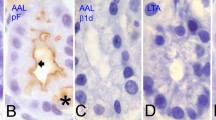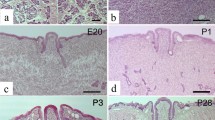Summary
Using immunostaining with monoclonal antibodies (mAbs) from three different sources as well as anti-B lectin, GSAI-B4 staining and α-galactosidase digestion, blood group B antigens were localized and analysed in tissue sections of sublingual glands from blood group B and AB individuals. Quantitative analysis of galactose was simultaneously carried out on the supernatant enzyme solution used for treating tissue sections by high-performance liquid chromatography (HPLC). In addition, galactose liberated from the pancreas tissues of blood group B and AB individuals was also estimated by HPLC analysis in order to compare the content of antigens. mAb-B(H079) and GSAI-B4 reacted uniformly with the mucous cells from blood group B and AB secretors. On the other hand, other mAbs-B(B006 and A582) recognized the antigen in a limited number of cells or was even negative in some cases of blood group AB individuals. Only mAb-B(H079) recognized the B antigens in mucous cells from non-secretors. Digestion with α-galactosidase resulted in the consistent appearance of H and Leb antigens in the mucous cells of all the secretors examined, although the reduction of staining intensity with anti-B reagents was not so marked. Ley antigens also appeared in some cases after the enzyme digestion. In non-secretors, Leb and Ley antigens, but not H antigens, appeared in some mucous cells following enzyme digestion. HPLC analysis of galactose revealed that α-galactosidase can specifically liberate the terminal galactose residues of B antigens, and no marked difference was present in the content of liberated galactose from mucous cells of sublingual glands among the individuals investigated (8.5–11.7 nmoles cm−2). No galactose was detected in samples from the sublingual glands of non-secretors, and only a trace amount of galactose was detected in the samples from pancreas tissues. These results suggest that the observed difference in the reactivity of different reagents with each tissue site can be ascribed to both quantitative and qualitative heterogeneity of B antigens.
Similar content being viewed by others
References
Anstee, D. J. (1990) Blood group-active surface molecules of human red blood cell. Vox Sang. 58, 1–20.
Evans, E. & Fung, Y. C. (1972) Improved measurements of erythrocyte geometry. Microvasc. Res. 4, 335–47.
Hardy, M. R., Townsend, P. R. & Lee, Y. C. (1988) Monosaccharide analysis of glycoconjugates by anion exchange chromatography with pulsed amperometric detection. Anal. Biochem. 170, 54–62.
Harpaz, N., Flowers, H. M. & Sharon, N. (1975) Studies on B-antigenic sites of human erythrocytes by use of coffee bean α-galactosidase. Arch. Biochem. Biophys. 170, 676–83.
Herp, A., Wu, A. M. & Moschera, J. (1979) Current concept of the structure and nature of mammalian salivary mucous glycoproteins. Molec. Cell Biochem. 23, 27–44.
Honda, S., Akao, E., Suzuki, S., Okuda, M., Kakehi, K. & Nakamura, J. (1989) High-performance liquid chromatography of reducing carbohydrates as strongly ultraviolet-absorbing and electrochemically sensitive 1-phenyl-3-methyl-5-pyrazolone derivatives. Anal. Biochem. 180, 351–7.
Ito, N. & Hirota, T. (1992) Histochemical and cytochemical localization of blood group antigens. Prog. Histochem. Cytochem. (in press).
Ito, N., Nishi, K., Nakajima, M., Matsuda, Y., Ishitani, A., Mizumoto, J. & Hirota, T. (1986) Localization of blood-group antigens in human pancreas with lectin—horseradish peroxidase conjugates. Acta Histochem. Cytochem. 19, 205–18.
Ito, N., Nishi, K., Kawahara, S., Okamura, Y., Hirota, T., Rand, S., Fechner, G. & Brinkmann, B. (1990a) Difference in the ability of blood group-specific lectins and monoclonal antibodies to recognize the ABH antigens in human tissues. Histochem. J. 22, 604–14.
Ito, N., Nishi, K., Nakajima, M., Okamura, Y. & Hirota, T. (1990b) Histochemical localization and analysis of blood group-related antigens in human pancreas using immunostaining with monoclonal antibodies and exoglycosidase digestion. J. Histochem. Cytochem. 38, 1331–40.
Kobata, A. (1979) Use of endo- and exoglycosidases for structural studies of glycoconjugates. Anal. Biochem. 100, 1–14.
Mowry, R. W. (1983) Selective staining of pancreatic beta-cell granules. Arch. Pathol. Lab. Med. 107, 464–8.
Takemoto, H., Hase, S. & Ikenaka, T. (1985) Microquantitative analysis of neutral and amino sugars as fluorescent pyridylamino derivatives by high-performance liquid chromatography. Anal. Biochem. 14, 24–50.
Author information
Authors and Affiliations
Rights and permissions
About this article
Cite this article
Ito, N., Tabata, S., Kawahara, S. et al. Histochemical analysis of blood group antigens in human sublingual glands and pancreas. An application of high-performance liquid chromatography to estimate the quantity of galactose liberated from tissue sections by α-galactosidase digestion. Histochem J 25, 242–249 (1993). https://doi.org/10.1007/BF00163820
Received:
Revised:
Issue Date:
DOI: https://doi.org/10.1007/BF00163820




